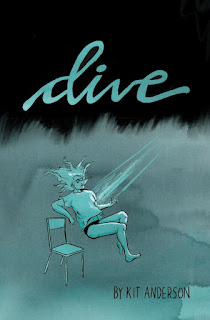Kit Anderson is an exceptional young talent. With years of graphic design experience, it's obvious that her comics are well-considered in terms of composition. However, despite her obvious skill as an illustrator, there's a welcome lack of slickness in her work. It is just visceral enough to really draw in the eye instead of repelling it. Anderson is also the rare CCS artist explicitly interested in literary/alternative comics, a form of comics storytelling that's become less dominant in the past few years. It's clear that they excel in this milieu.
Anderson is interested in the emotional ramifications of being caught betwixt and between. Her comics also deal explicitly with memory and identity. "Glasshouse Transcript" is an interview with a woman about a past memory of meeting with a friend during the lunch break of her job. Formally, Anderson does a number of interesting things here. Each page is a single image. We never see any people, except in faint outlines as part of memories. The narrative captions are one-sided, entirely from the woman's point of view. We never learn why she's being interviewed or by whom. The focus of the "action" is on a bench in the glasshouse, a visual metonym for longing, happiness, and then loss. The ink wash gives the entire thing an atmosphere of nostalgia and regret, and the slightly enigmatic ending doesn't mute the sense of what was lost--and why, as this was a queer relationship that could never be.
Dive, an entry for a CCS anthology, is another story about an in-between space in a journey. One can see Anderson experimenting with figure work possibilities, with some drawings more successful than others. The real attraction here is a quiet, desperate kind of storytelling as Anderson depicts an abusive relationship defined by poor communication, a crisis that becomes literal as a woman at first seems to drown, and a surreal ending that metaphorically depicts the end of a transformative journey. There's more than a little touch of David Lynch here, and the blue color wash that appears highlights that use of light and color as a transformative narrative element.
Quests is something completely different. It's cartoony, but also carefully cross-hatched. It's in full color, but the colors are muted and restrained. The short story here may as well be a metaphor for being an artist: it's an eccentric man who may be a wizard and whose motivations are unclear. He works to save a baby bird using certain techniques, including some yarn he's purchased, then moves on. It's a story about the ways in which narratives brush against each other, briefly existing in the same orbit before moving on.
Country Lane is about another relationship and another liminal space. It's about a couple where one half isn't ready to fully commit by moving in, in part because that adds a certain finality to the decision. She also has trouble sleeping (a symptom of being betwixt and between to be sure), and her partner downloads the sort of sleeping-guide app that is familiar to anyone who's ever had trouble sleeping. The comic concludes with her listening to the recording and it turning into something else, concluding with standing outside out of a house at night, seeing someone waiting for them. The guiding voice asks, "Are you going to go in?" It's a brilliant, subtle exploration of the subconscious, where one knows what the right answer to the question is but can't quite pull the trigger. The narrative is left unresolved, because the story is about this indecision and self-inflicted misery. The use of yellow as a spot color is careful, because the girlfriend's shirt is yellow, and that color is repeated throughout the story.
The Whorl is the first part of a larger story that also stands on its own. Here, Anderson dips further into horror. Not so much gore or monsters, but the ways in which the unexplained and a loss of identity is a terrifying experience. It's about two sisters going through a morning routine. One of them (Allie) is an early riser who loves to go running, and the other (Claire) prefers to get up later. One morning, Allie finds something unusual out in nature: some kind of whorl phenomenon. Whether it's light or energy or water or sound or something else is unclear and irrelevant. However, when she photographs it and sends it to Claire, there's a gap of time. The only clue that there's something amiss is that the cat freaks out. Later, Claire shows the unusual photo of Allie and the whorl to a friend...but has no idea who Allie is. She has never existed. It's a moment of existential terror to lose track of one's own identity, but it's just as bad for the reader when someone close to her disappears as well. Anderson uses a graywash here as well and a naturalistic approach, but this time it's all used to establish mood.
Anderson seems like she's trying to figure out exactly what kind of cartoonist she wants to be, as she dips in and out of genre in interesting ways. Each mini is quite good on its own, but taken together it really informs the reader that this is a restless, probing talent matching her themes against her use of technique in genre in a restrained, mature fashion.







No comments:
Post a Comment